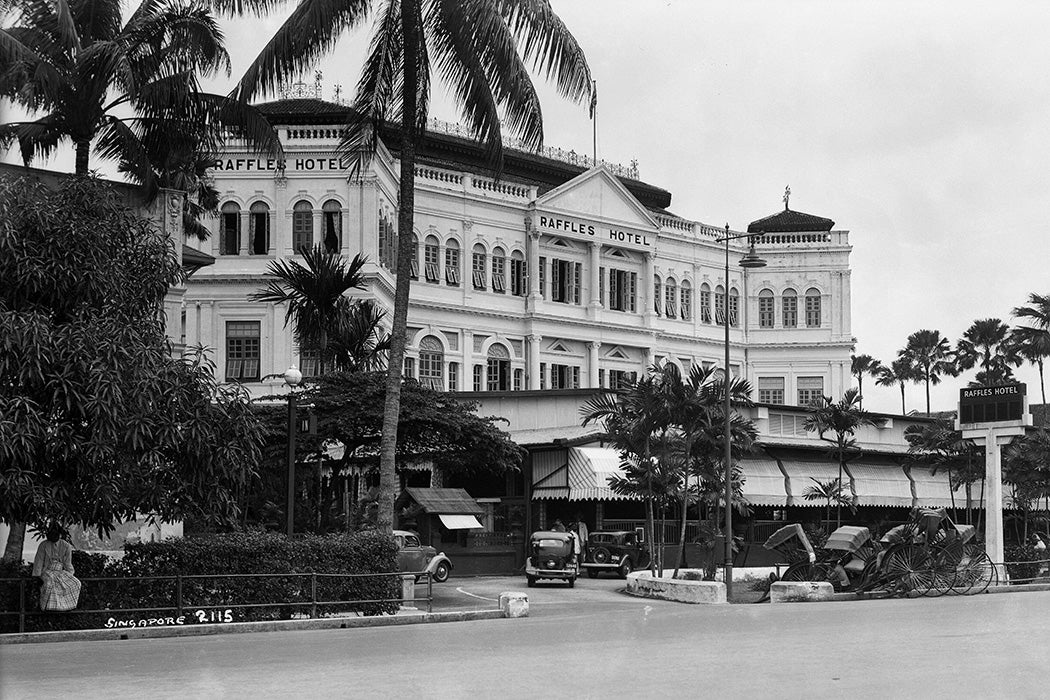In colonial India and Southeast Asia, Palladian façades, modern plumbing, and a six-foot Sikh doorman were just some features Western tourists could expect at European-style “grand hotels.” In the late nineteenth and early twentieth centuries, such “hotels were a fixture of colonial urban life,” reports historian Maurizio Peleggi, who argues that these sites operated as “microcosms of empire.”
By studying luxury establishments such as Colombo’s Galle Face Hotel and Singapore’s Raffles Hotel, which are still in business today, he examines how “hotels were traversed by the same tensions and ambivalences that destabilized the colonial project.”
The architecture and infrastructure of these European hotels were marked by imperial tastes. For example, the Raffles Hotel has a “Palm Court” that separates its main building and suite wing—a landscaping choice that Peleggi links to British colonials’ public garden obsession.
Similarly, imperialism tinged the service on offer. Peleggi notes that, “exploiting the symbolic capital Sikhs derived from their conspicuous presence in the colonial police, some hotels started employing them as uniformed doormen,” a practice that continues at the Raffles Hotel even now.
But the social customs at play in colonial hotels expose the cultural anxieties of empire as well.
The Raffles Hotel’s Long Bar is synonymous today with the “Singapore Sling,” a sweet pink drink invented in the 1910s by bartender Ngiam Tong Boon, possibly to suit women guests. Yet Peleggi points out that iconic tipple might have been outrageous in some circles at the time of its introduction.
“Besides member-only clubs, hotels represented the only other public venue for social drinking in the colonial city. Both clubs and hotels were, at least until the interwar period, male environments,” he explains. “So, when the Adelphi Hotel, considered Singapore’s third-best, introduced the American bar at the start of the 1900s, the initial reaction was scornful, since cocktails were seen as inappropriate drinks for men.”
The “color bar” was also fraught in colonial hotels, some of which were owned and run by Arab, Jewish, and Armenian entrepreneurs. These investors and managers were from ethnic groups who, like Eurasians, complicated the social distinctions between whites and non-whites.
“Colonial hotels rarely excluded patrons on the basis of race, given also the occasional visits by traveling Asian royalty, but tended to segregate them in more or less subtle forms,” writes Peleggi.
For instance, Eurasians could patronize the Raffles Hotel, “but they are put off somewhere in a corner of the dining room, given slow service and cold food, and generally made to fell that they are not wanted,” one colonial source states. “So they don’t come again.”
Meanwhile, room attendants and other hotel servants largely drew from a male Asian workforce. These workers were feminized by Western visitors, who sometimes mistakenly saw them as “maid instead of men servants,” as one guidebook to Ceylon (Sri Lanka) put it.
“Given the easing of inhibitions afforded by travel’s transitory condition,” Peleggi writes, “one can assume homoerotic intimacy and sexual encounters between male tourists and local youth, particularly servants in hotels and boarding houses, to have also been not infrequent.”
Weekly Newsletter
He identifies this situation as another example of “cross-racial intimacy,” alongside controversial incidents such as the presence of white barmaids and European sex workers in the colonial city.
By the 1930s, European-style hotels in the colonies had lost their sheen, and Peleggi notes that “their premises were in need of refurbishment, while their allure as elite venues was countered by more inclusive recreational sites” like cinemas and theme parks. Still, some survived and went through high-profile refurbishment in the 1990s.
“[B]y interweaving historical anecdotes and literary inventions, their promotional narratives complement the rehabilitation of hotels into heritage sites of sort [sic],” he explains, “where the colonial past is represented as a stage set for tourist consumption—and, indeed, as a consumable spectacle in itself.”







